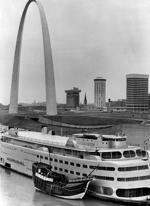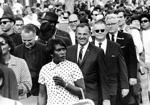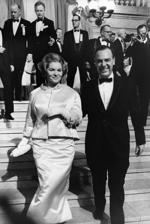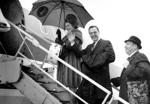This is the A1 story announcing the death of St. Louis' former Mayor Alfonso Juan Cervantes, at 62. It ran on June 24, 1983.
Look back on the life of Alfonso Cervantes, former mayor, born on ... - St. Louis Post-Dispatch
This is the A1 story announcing the death of St. Louis' former Mayor Alfonso Juan Cervantes, at 62. It ran on June 24, 1983.

Mayor Alfonso J. Cervantes on March 6, 1965, two days before he won the Democratic primary for mayor. Cervantes served two terms in office. Proud of his Spanish heritage, he brought from New York a replica of the Santa Maria, flagship of explorer Christopher Columbus, and the Spanish Pavilion, both from the New York World's Fair. Photo by Buell White of the Post-Dispatch
Alfonso Juan Cervantes, a colorful but often quixotic mayor of St. Louis for eight years and a tireless civic promoter both in and out of City Hall, died Thursday at age 62.
Mr. Cervantes was the city's 19th mayor, serving from 1965 to 1973.
Mr. Cervantes will be remembered as the mayor who helped bring to the city some lasting institutions, such as the Cervantes Convention Center, which bears his name. He also brought some that didn't last, such as the Santa Maria, a copy of Christopher Columbus' flagship.
He died at 2:05 p.m. at Barnes Hospital, ending a battle with cancer that he had fought for several years. He had entered the hospital on June 9 with a respiratory infection, apparently brought on by the disease.
People are also reading…
On Thursday, the three men who succeeded Mr. Cervantes as mayor praised his service to the city.
Mayor Vincent C. Schoemehl Jr., said the "rebirth of the St. Louis riverfront and downtown serve as daily reminders of the efforts put forth by Al Cervantes to get St. Louis on the move."
John H. Poelker, who defeated Mr. Cervantes in the Democratic primary in 1973, said the two had remained friends despite a heated campaign.
Mr. Cervantes' aggressive promotion of St. Louis, Poelker said, "reawakened in the minds of people the possible resurgence of the city, particularly in downtown."
James F. Conway, who defeated Mr. Cervantes in a comeback attempt in the 1977 primary, said Mr. Cervantes always had been "loaded with ideas."
Mr. Cervantes challenged the community to tackle its problems in different ways, Conway said.
Mr. Cervantes' administration was marked by flamboyance and showmanship, but his accomplishments remain highly visible. They include, in addition to the bond issue for the Cervantes Convention Center:
• Revival of the mounted police unit.
• Establishment of the Mayor's Office on Aging and the city's Commission on Civil Rights.
• Establishment of the St. Louis Ambassadors, an organization that promotes the city.
• The move of the Spanish Pavilion from the 1964 World's Fair site in New York to St. Louis. It now forms the base of the Marriott's Pavilion Hotel next to Busch Stadium.
Mr. Cervantes did not leave the public eye after leaving public office. He led a redevelopment campaign for the Maryland Plaza area and was president of Laclede Cab Co. and of Cervantes & Associates Inc., an insurance agency.
In February, Mr. Cervantes was honored by about 400 friends at a reception at the Convention Center. During the night, Mr. Cervantes unveiled a bust of himself, and Schoemehl declared observance of an Alfonso J. Cervantes Day.
From the time Mr. Cervantes took office as mayor in 1965, he began promoting the idea of a major new downtown convention center, a project that he envisioned would provide many new jobs and propel St. Louis into the lucrative — but competitive — national and regional convention business.
At the time, St. Louis' convention facilities consisted of the aging Kiel Auditorium and the Arena (Editor's note: renamed by 1983 to the Checkerdome, and demolished in 1999).
Mr. Cervantes' initial effort ended in defeat in 1971, when St. Louis voters turned down a $20 million bond issue. But 18 months later, at Mr. Cervantes' urging, the proposal went back on the ballot. Voters did an about-face and passed a $25 million issue for the center.
The former mayor's promotion of two other projects, the Santa Maria and the Spanish Pavilion, ended less happily.

The Santa Maria, a replica of the sailing ship that Christopher Columbus took on his voyage across the Atlantic Ocean 1942, rests against the S.S. Admiral excursion steamer. The photo was taken on March 29, 1969, the day the Santa Maria was pushed upriver to the St. Louis Levee. Mayor Alfonso J. Cervantes, who was proud of his Spanish heritage, twisted the arms to some of his supporters to buy it at auction in Washington in a bidding war against one of the Rockefellers. Spain built the replica for the 1964 World's Fair in New York. Later, it failed as a tourist stop on the Potomac River in Washington. Towboats pushed the Santa Maria along the Intracoastal Waterway and up the Mississippi River, lashed to a tow of barges. Here, it awaits its masts and a permanent mooring on the cobblestone landing. (Post-Dispatch)
The New York World's Fair was the origin of both enterprises. Then-Mayor Cervantes, who was of Spanish extraction, became interested in the Santa Maria after the 80-foot vessel had been displayed at the fair and then moved to Washington.
Mr. Cervantes and a consortium of business associates bid $375,000 for the Santa Maria and brought it here for display on the riverfront.
That was in January 1969. But by June, the Santa Maria rested on the bottom of the Mississippi River, having been torn from its moorings and smashed against a dock by a violent storm.
The vessel was patched up and returned to the riverfront, but it never realized its owners' hopes as a tourist attraction. Eventually it was bought by out-of-town interests and taken to Titusville, Fla., where it was desroyed by fire.

The Spanish Pavilion ready for its grand opening on May 25, 1969. (Arthur Witman/Post-Dispatch)
The Spanish Pavilion, too, was an initial failure. It was assured of existence only when it became part of the hotel.
The $10 million building, hailed by some architects as the 'jewel of the New York fair, 'suddenly became surplus propery when the fair closed and the Spanish government sought to get rid of it.
Sensing an opportunity, Mayor Cervantes promoted relocation of the pavilion here and spearheaded a fund- raising drive, including a public subscription scheme that created much popular support for the enterprise.
At length, he was able to approach the government of Spain with $630,000 — enough to convince it that the city was serious about getting the pavilion.
The building was dismantled stone by stone, brought to St. Louis and reconstructed just north of Busch Stadium.
The night the pavilion opened served as a celebration of the mayor's civic triumph. For a time afterward, its galleries, restaurants, night club and theater were the center of public social life in St. Louis.
But nine months later, the building was empty and dark, closed because of financial problems. In 1974, Breckenridge Hotels took it over and added a hotel tower, renaming it The Inn of the Spanish Pavilion. The hotel is now Marriott's Pavilion.
Mr. Cervantes, long a resident of Westmoreland Place in the Central West End, was well acquainted with Maryland Avenue, which for decades was the poshest shopping district in the metropolitan area. But by the early 1970s, most of the elegant stores had moved away, and the 'The Avenue 'was facing problems.
When Mr. Cervantes left office in 1973, he undertook to redevelop Maryland Plaza. He bought the Fairmont Hotel and eventually acquired ownership or control of most other properties in the redevelopment area.
The project became the most controversial of Mr. Cervantes' career. Elements of it, including an ordinance endowing Mr. Cervantes' Maryland Plaza Redevelopment Corp. with urban renewal powers, remain under challenges in court a decade later.
Mr. Cervantes was born on Aug. 27, 1920, at 3723 Juniata Street in south St. Louis. He was the great-grandson of Spanish immigrants. He was educated in Catholic schools and attended St. Louis University High School for about a year.
Later, he went to Hadley Vocational School for a short time but had little interest in school. At age 15, he left for California to become a wallpaper hanger.
In California, Mr. Cervantes' talent as a promoter blossomed. In Hollywood, he organized rhumba contests and made a comfortable living until the United States entered World War II in December 1941. Mr. Cervantes then enlisted in the Merchant Marine.
At the end of the war, he returned to St. Louis and attended night classes at St. Louis University while starting his business career.
His business flourished, and soon he was head of his own insurance agency and president of Laclede Cab Co. He got into the taxicab business when the owner of Laclede was unable to meet his insurance bill and offered Mr. Cervantes a half interest in the firm in lieu of payment.
In 1949, when Mr. Cervantes was 28, he became involved in Democratic politics and was elected to the Board of Aldermen from the 15th Ward.
Controversy began with his election to office. He and another newly elected alderman were accused of not living in the wards they represented. Both were subsequently seated after a board meeting during which passions ran so high that the late Sheriff Thomas F. Callanan punched the board's parliamentarian in the nose.
More enduring controversy also swirled around Mr. Cervantes. A conflict-of-interest issue first was raised in 1950 when his Laclede Cab Co. got permission from the Board of Public Service to put 35 more cabs on the street, despite an application several months earlier from a rival cab firm.
Laclede Cab became an issue again when it requested permission to erect a radio antenna on the top of City Hospital. Mr. Cervantes said the antenna would be used for taxicab business but also offered to make it available to civil defense authorities to dispatch emergency vehicles. The request ultimately was denied.
Mr. Cervantes was re-elected as alderman in 1953 and at mid-term made an unsuccessful campaign for the board presidency.
He was cited at the time by the St. Louis Junior Chamber of Commerce for initiating monthly 'beef sessions 'for the public at City Hall. The sessions, which Mr. Cervantes started as chairman of the aldermanic public welfare committee, were early versions of the 'town meetings 'he held later after being elected mayor.
In 1957, Mr. Cervantes was re-elected alderman and two years later made a second attempt at the aldermanic presidency. He won, defeating Alderman Alfred I. Harris in the Democratic primary. An aid to his victory was his endorsement by then- Mayor Raymond Tucker and then- Comptroller John H. Poelker. He then defeated the Republican candidate in the general election.
Mr. Cervantes always gave great credit to his wife, Carmen, for her help in campaigns. It was their customary practice to go door-to-door, Mrs. Cervantes on one side of the street and Mr. Cervantes on the other.
When Mr. Cervantes sought re-election as aldermanic president in 1963, Tucker backed Donald Gunn, who won the Democratic nomination and the general election.
Another conflict-of-interest charge was raised in the 1963 campaign when Mr. Cervantes acknowledged that one of his insurance companies had sold bonds on seven constables to the city. At the time, Mr. Cervantes was co-sponsor of a conflict-of-interest bill pending before the alderman.
After his defeat, Mr. Cervantes was out of public office for the first time in 14 years. But he set his sights on the mayor's office and used his time to plan a campaign against Mayor Tucker in 1965.
By then, Mr. Cervantes had accumulated what he called a 'portfolio full 'of business interests. The Cervantes & Associates Inc. insurance agency and Laclede Cab Co. remained the major interests. But he also was co-owner of Consolidated Service Car Co. and owned a large share in Resort Corp. of Missouri, which operates the Lodge of the Four Seasons at Lake of the Ozarks.
In addition, Mr. Cervantes held an interest in the Continental Building in midtown St. Louis and was a vice president and registered agent for Group Underwriters Mutual Insurance Co.
In the 1965 mayoral primary, Mr. Cervantes's business holdings became one of the chief objects of attack by Mayor Tucker and his supporters, who charged that the business ties would make Mr. Cervantes subject to conflicts of interest.
Mr. Cervantes met the charge with a promise to put his business interests in trust if elected. He defeated Mayor Tucker's attempt at a fourth term, winning the primary by 81,330 votes to 66,888.
About two months after taking office, Mr. Cervantes reported that he had met the promise and had put some of his business holdings in trust or sold some interests. Among the interests sold were his shares in the Continental Building and Consolidated Service Car Co.
But critics charged that Mr. Cervantes still held control of his business interests because the trust was supervised by close friends.
Mr. Cervantes relished his flamboyant nature. It wasn't long after he took office that a Cadillac limousine showed up in the driveway at City Hall to serve the mayor.
Instead of the Fire Department worker who had driven previous mayors around in city cars, Mr. Cervantes hired Bill Jud, a former Laclede Cab driver, to be his chauffeur. Jud, in addition to his driving ability, become the mayor's photographer, confidant, bodyguard and jack-of-all- trades.
The appearance of the mayor's office was depressing to the new mayor, so he spent about $35,000 from bond issue funds and general revenue and threw out the drab beiges and dull greens. He hired William A. Bernoudy, an architect and interior designer, to spruce up the place.
Deep pile red carpet was brought in by the yards for the mayor's reception room and private office. Dark blue velvet sofas and red and white striped chairs adorned the reception room. Sofas and chairs covered with a black-and-white Spanish scroll design were placed in the mayor's private office.
Mr. Cervantes called the finished product 'the new spirit of St. Louis. The enthusiastic public reaction to the refurbishing job was a tribute to the mayor's salesmanship.
One of the Mr. Cervantes' first moves in office was to establish the St. Louis Ambassadors, a group brought together to promote the city. He also had a hand in settling strikes by employees of the Laclede Gas Co. and by musicians of the St. Louis Symphony Orchestra. The mayor also presided at the completion of the Gateway Arch.
The Consolidated Service Car Co. was sold to the Bi-State Development Agency, producing another controversy for Mr. Cervantes, who formerly had held an interest in the company. He was questioned about a conflict of interest in the sale, which went through City Hall, and was attacked because black drivers for Consolidated had lost their jobs.
On being inaugurated for his second term in office in 1969, Mr. Cervantes singled out crime in the streets as his No. 1 problem. Later in the year he started his "Challenge of the '70s" program to define the city's problems in crime, housing and related fields.
He sent his brother, the Rev. Lucius F. Cervantes, a Jesuit, to Washington to work full time in lobbying for federal help for St. Louis. The mayor had relied on his brother for advice on matters of social concern since taking office. Father Cervantes later returned to St. Louis to work on city welfare projects and was appointed commissioner of the St. Louis Area Agency on Aging.
In April 1970, Mr. Cervantes and Illinois Gov. Richard B. Ogilvie announced an agreement to establish a single-purpose airport authority to build and operate a $350 million airport across the Mississippi River in Illinois. This time, the controversy became metropolitan in scope, and debate about the need and site of the area's major airport continues to surface from time to time.
Mr. Cervantes suffered probably his biggest personal crisis in office in 1970 when Life magazine published an article alleging that the mayor had personal ties with the underworld. Mr. Cervantes bitterly denounced the article.
He filed a $12 million suit against the magazine, but the suit eventually was dismissed, and the U.S. Supreme Court refused an appeal by the mayor.
Although Mr. Cervantes often spoke of seeking higher offices — such as governor of Missouri — political observers saw the publicity surrounding the Life article as a major liability in the mayor's political plans.
In his quest for a third term, Mr. Cervantes met formidable opposition in the 1973 Democratic primary. The mayor's long-time City Hall associate and friend, Comptroller John H. Poelker, also filed in the Democratic mayoral race; the remnants of the Tucker faction rallied behind Poelker.
Toward the end of the primary race, the campaign become bitter, with Mr. Cervantes accusing Poelker of running a smear campaign. Poelker's backers had distributed a four-page newspaper entitled "The Truth," in which Poelker charged the mayor with raising millions for his pet projects but nothing to rehabilitate neighborhoods.
Newspaper articles at the time asserted that Mr. Cervantes had failed to stem the exodus of residents and businesses from the city -- the things he had criticized Mayor Tucker for allowing to happen.
In the primary election of March 4, 1973, Mr. Cervantes polled 43,340 votes to Poelker's 48,941.
Mr. Cervantes collected his mementos from the walls of his City Hall office — including several prized reproductions of editorial cartoons lambasting some of his actions — and returned to private life. But he continued his interest in politics and maintained his long-time support for U.S. Sen. Hubert H. Humphrey, D- Minn., in Humphrey's several bids for the presidency.
In 1977, Mr. Cervantes tried to return to the mayor's office by running in the primary against state Sen. James F. Conway. But the voters opted for Conway by a 3-to-2 margin.
At the time of his death, he was survived by his wife and brother, as well as a daughter, Judith Ann C. King of Chesterfield; five sons, Alfonso J. Jr. and Brett, both of Los Angeles, and Lucius, Barry and Cory, all of St. Louis; two sisters, Victoria Karches of St. Louis and Virginia Berry of San Diego; and two grandchildren.


St. Louis Mayor Alfonso J. Cervantes and his wife Carmen descend the marble stairway in the St. Louis City Hall rotunda to lead guests at Cervante's inaugural reception on April 20, 1965. Photo by James A. Rackwitz, St. Louis Post-Dispatch

Mayor Alfonso J. Cervantes (center) and his wife, Carmen, board a plane at Lambert Field with Harold Koplar for a flight to New York on Jan. 22, 1966, to celebrate a business deal.
Thanks for reading Look back on the life of Alfonso Cervantes, former mayor, born on ... - St. Louis Post-Dispatch. Please share...!

0 Comment for "Look back on the life of Alfonso Cervantes, former mayor, born on ... - St. Louis Post-Dispatch"